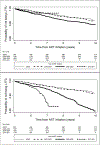Long-term loss to follow-up in the TREAT Asia HIV Observational Database (TAHOD)
- PMID: 30980495
- PMCID: PMC6639129
- DOI: 10.1111/hiv.12734
Long-term loss to follow-up in the TREAT Asia HIV Observational Database (TAHOD)
Abstract
Objectives: With earlier antiretroviral therapy (ART) initiation, time spent in HIV care is expected to increase. We aimed to investigate loss to follow-up (LTFU) in Asian patients who remained in care 5 years after ART initiation.
Methods: Long-term LTFU was defined as LTFU occurring after 5 years on ART. LTFU was defined as (1) patients not seen in the previous 12 months; and (2) patients not seen in the previous 6 months. Factors associated with LTFU were analysed using competing risk regression.
Results: Under the 12-month definition, the LTFU rate was 2.0 per 100 person-years (PY) [95% confidence interval (CI) 1.8-2.2 among 4889 patients included in the study. LTFU was associated with age > 50 years [sub-hazard ratio (SHR) 1.64; 95% CI 1.17-2.31] compared with 31-40 years, viral load ≥ 1000 copies/mL (SHR 1.86; 95% CI 1.16-2.97) compared with viral load < 1000 copies/mL, and hepatitis C coinfection (SHR 1.48; 95% CI 1.06-2.05). LTFU was less likely to occur in females, in individuals with higher CD4 counts, in those with self-reported adherence ≥ 95%, and in those living in high-income countries. The 6-month LTFU definition produced an incidence rate of 3.2 per 100 PY (95% CI 2.9-3.4 and had similar associations but with greater risks of LTFU for ART initiation in later years (2006-2009: SHR 2.38; 95% CI 1.93-2.94; and 2010-2011: SHR 4.26; 95% CI 3.17-5.73) compared with 2003-2005.
Conclusions: The long-term LTFU rate in our cohort was low, with older age being associated with LTFU. The increased risk of LTFU with later years of ART initiation in the 6-month analysis, but not the 12-month analysis, implies that there was a possible move towards longer HIV clinic scheduling in Asia.
Keywords: HIV; Asia; long term; lost to follow-up.
© 2019 British HIV Association.
Conflict of interest statement
Conflicts of Interest
There are no conflicts of interest.
Figures
References
Publication types
MeSH terms
Grants and funding
- U01AI069907/National Institute on Drug Abuse, as part of the International Epidemiology Databases to Evaluate AIDS/International
- US National Institutes of Health's National Institute of Allergy and Infectious Diseases/International
- CA/NCI NIH HHS/United States
- NMRC/CSA-INV/0002/2016/NMRC Clinician Scientist Award/International
- MH/NIMH NIH HHS/United States
LinkOut - more resources
Full Text Sources
Medical
Research Materials


